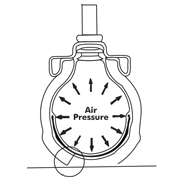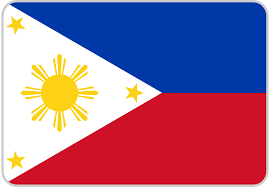250 cc engine
Tyres With Tube
The tyres that are fitted on your motorcycle are designed to match the performance capabilities of your motorcycle and provide the best combination of handling, braking, durability and comfort. To safely operate your motorcycle, the tyres must be of recommended type and size, in good conditon with adequate tread, and correctly inflated.
Air Pressure
Properly inflated tyres provide the best combination of handling, tread life and riding comfort. Generally, under inflated tyres wear unevenly, adversely affect handling, and are more likely to fail from being overheated.Under inflated tyres can also cause wheel damage in rocky terrain.
Over inflated tyres make your motorcycle ride more harshly, are more prone to damage from surface hazards, and wear unevenly.Make sure the valve stem caps are secure. If necessary, install a new cap.
Caution
Over inflation / under inflation will affect the performance.
Inspection
Whenever you check the tyre pressure, you should also examine tyre treads & side walls for wear, damage 7 foreign objects.
Look for:
- Bumps or bulges in the side of the tyre or the tread. Replece the tyre if you find any bumps or bulges.
- Cuts, splits or cracks in the tyre.
- Excessive tread wear.
Note
If you hit a pothole or hard object, pull to the side of the road as soon as you safely can and carefully inspect the tyres for damage.
Tread Wear
Replace tyres immediately when the wear indicator appears on the tyre. Check the tread wear indicator for tyre wear.
Unidirectional Tyres
Ensure the arrow mark on the tyre is in the same direction as that of forward rotation of the wheel, whenever the tyre is removed and put back in case of puncture.
Warning
- By Using tyres that are excessively worn or improperly inflated can cause a crash in which you can be seriously hurt or killed.
- Operation with excessively worn tyres is hazardous and will adversely affect traction and handling.
- Follow all instructions in this owner’s manual regarding tyre inflation and maintenance.
- Under-inflation may result in the tyre slipping on or tyre coming off the rim.
Tubeless Tyres
The tyres fitted on your motorcycles are of TUBELESS type.
To safely operate your motorcycle, your tyres must be of the proper type and size, in good condition with adequate tread, and correctly inflated for the load you are carrying. The following pages give more detailed information on how and when to check the air pressure, how to inspect your tyres for damage and what to do when your tyres need to be repaired or replaced.
Warning
Using tyres that are excessively worn or improperly inflated can cause a crash in which you can be seriously hurt or killed.Follow all instructions in this owner's manual regarding tyres inflation and maintenance.
Air Pressure
Keeping your tyres properly inflated provides the best combination of handling, tread life and riding comfort. Generally, under-inflated tyres wear unevenly, adversely affect handling and are more likely to fail from being overheated.
Over-inflated tyres make your motorcycle ride harshly, are more prone to damage from road hazards, and wear unevenly.
We recommend that you visually check your tyres before every ride and use a gauge to measure air pressure at least once a month or any time you think the tyres pressure might be low.
Tubeless tyres have some self-sealing ability if they are punctured. However, because leakage is often very slow, you should look closely for punctures whenever a tyre is not fully inflated.
Always check air pressure when your tyres are "cold" - when the motorcycle has been parked for at least three hours. If you check air pressure when your tyres are "warm" - when the motorcycle has been ridden for even a few kms - the readings will be higher than if the tyres were "cold". This is normal, so do not let air out of the tyres to match the recommended cold air pressures given below. If you do, the tyres will be under-inflated.
Caution
Over inflation / under inflation will affect the performance.
Inspection
Whenever you check the tyre pressure, you should also examine tyre treads & side walls for wear, damage 7 foreign objects.
Look for:
- Bumps or bulges in the side of the tyre or the tread. Replece the tyre if you find any bumps or bulges.
- Cuts, splits or cracks in the tyre.
- Excessive tread wear.
Note
If you hit a pothole or hard object, pull to the side of the road as soon as you safely can and carefully inspect the tyres for damage.
Tread Wear
Replace tyres immediately when the wear indicator appears on the tyre. Check the tread wear indicator for tyre wear.
Unidirectional Tyres
Ensure the arrow mark on the tyre is in the same direction as that of forward rotation of the wheel, whenever the tyre is removed and put back in case of puncture.
Warning
- BUsing tyres that are excessively worn or improperly inflated can cause a crash in which you can be seriously hurt or killed.
- Operation with excessively worn tyres is hazardous and will adversely affect traction and handling.
- Follow all instructions in this owner’s manual regarding tyre inflation and maintenance.
- Under-inflation may result in the tyre slipping on or tyre coming off the rim.
Note
For repair and replacement of tyre it is advised to visit your Authorised Hero MotoCorp workshop.
Important Safety Reminders
- Do not install a tube inside a tubeless tyre on this motorcycle. Excessive heat buildup can cause the tube to burst.
- Use only tubeless tyres on this motorcycle. The rims are designed for tubeless tyres, and during hard acceleration or braking, a tube-type tyre could slip on the rim and cause the tyre to rapidly deflate.
Tube With Puncture Endurance
Tube with Puncture Endurance is a genuine part specially designed for the tyre of your scooter.
Features
See the following drawings for the "Tube with Puncture Endurance" structure. It has a "fluid chamber" filled with a special fluid at the ground side of the tube as shown. When a sharp object such as a nail etc. pierces into the tyre, fluid is pushed out by the air pressure plugging up the hole with the fiber in the fluid. Thus, the “Tube with Puncture Endurance” is designed to minimize air leakage.
Note
Tube with Puncture Endurance is not designed to prevent every puncture damage of the tube Use the Tube with Puncture Endurance on the scooter equipped with the genuine tyres. Note that the Tube with Puncture Endurance are available in every size, which are designated for the tyres of the corresponding size respectively. Do not use the tube in combination with the tyre of the different size.
The Tube with Puncture Endurance is structured to be tough against air leakage when a sharp object pierces into the tyre. Note that a foreign material can get stuck into the tyre no matter the tyre pressure may look to be normal. Remove the foreign material from the tyre when it is found during the daily check and repair the tube as soon as possible.
When the rim or tyre is wet with the fluid or when the tyre pressure is low, check the tyre for a foreign material and remove it. Repair the tube immediately.
The fluid can come out when removing the foreign material from the tyre. Take care not to get the fluid on you.
The damage that can be repaired is up to 3 mm in size. When the damage is larger than 3 mm, replace the tube.
When replacing the tyre, select the new tube of the same size.
Use the tube with the specified air pressure.
To check for puncture before or after repair, inflate the tube as large as the tyre inner dia meter size (i.e. to the degree that maintains the cylinder of the tube). On the fluid chamber side, this can be checked with the fluid oozing out of the chamber, excessive inflation of the tube will cause the air to enter the fluid chamber, deteriorating the puncture function. (the material of liquid: anti freeze mixture, fiber, etc)
Caution
Wash out the fluid thoroughly with water when it gets on your skin or in your eyes and get the medical attention promptly.
Damages to which Tube with Puncture Endurance is not effective:
(1) Burst
(2) Damage outside the grounding surface of the tyre (e.g. rim, sides of tyre, etc, that are not mounted with the fluid chamber)
(3) Damaged or rubbed with a rusted nail, etc.
(4) Large damage or L- shaped damage
(5) Damages resulted from neglect of the above note.






























 Angola
Angola
 Argentina
Argentina
 Bangladesh
Bangladesh
 Bolivia
Bolivia
 Colombia
Colombia
 Costa Rica
Costa Rica
 Dominican Republic
Dominican Republic
 DRC
DRC
 Ecuador
Ecuador
 El Salvador
El Salvador
 Ethiopia
Ethiopia
 GCC
GCC
 Guatemala
Guatemala
 Guinea
Guinea
 Guyana
Guyana
 Haiti
Haiti
 Honduras
Honduras
 Kenya
Kenya
 Madagascar
Madagascar
 Mexico
Mexico
 Myanmar
Myanmar
 Nepal
Nepal
 Nicaragua
Nicaragua
 Nigeria
Nigeria
 Panama
Panama
 Peru
Peru
 Philippines
Philippines
 South Africa
South Africa
 Sri Lanka
Sri Lanka
 Tanzania
Tanzania
 Trinidad
Trinidad
 Turkey
Turkey
 Uganda
Uganda
 Zambia
Zambia


